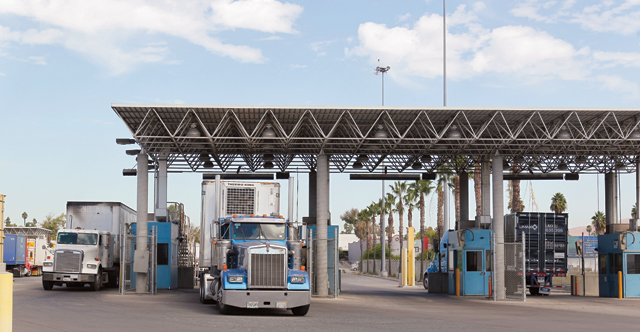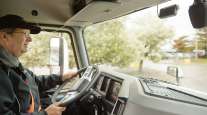Cross-Border Fleets Use Software to Manage Data, Prevent Delays
 John Sommers II for Transport Topics
John Sommers II for Transport TopicsThis story appears in the April 17 print edition of iTECH, a supplement to Transport Topics.
Cross-border shipments involve many moving parts, and any delays or errors in providing key information to customs agencies can prove costly to shippers and carriers alike.
To help manage this added complexity, some carriers have implemented software and systems designed to increase accuracy, reduce paperwork for all parties and minimize rejections at international border crossings.
U.S. Customs requires detailed shipment information, including the full description, weight and piece count — the number of skids, pallets or boxes — as well as the commercial invoice. Any discrepancies in that information can lead to delays, said Lance Dixon, senior vice president for Mexico and Canada at Werner Enterprises.
BEST OF APRIL iTECH: More stories, columns
The carrier operates many facilities at its southbound crossing points, including one in Laredo, Texas, where 600 pieces of equipment enter and leave daily.
To manage these border crossings, Werner has developed its own software, dubbed E-Z Cross, to streamline the process. Drivers fax over their bills of lading and other documents, which Werner processes electronically.
“If there are any issues on the paperwork whatsoever, we can start working on those before it hits the border,” Dixon said, adding that something as simple as missing piece count can cause a delay.
Werner, which is based in Omaha, Nebraska, ranks No. 15 on the Transport Topics Top 100 list of the largest for-hire carriers in the United States and Canada.
Clear descriptions, harmonized tariff codes and complete shipper and receiver addresses are a few of the basic items that reduce the risk of a clearance delay, said Wayne Swaby, national manager of regulatory affairs and compliance for Purolator Holdings Ltd., a transportation provider based in Mississauga, Ontario.
“Technology helps to highlight obvious problems that may occur at the border and gives the user the opportunity to make corrections prior to dispatching information to the customs agency or arrival at the border,” Swaby said.
Purolator Holdings ranks No. 26 on the for-hire TT100.
The use of electronic data interchanges speeds crossings and improves service and driver productivity, said Jason Andrus, chief financial officer of Doug Andrus Distributing, a carrier based in Idaho Falls, Idaho.
“In the past, the challenge of cross- border freight was the coordination of paper- work to the border before the truck arrived,” Andrus said.
Meanwhile, truckload carrier Celadon Group Inc. has created a custom system for northbound loads coming from Mexico that manages border crossing requirements and ties into the company’s load planning software, said George Chasteen, president of international business operations at the fleet.
The system also integrates with the web portal for the Automated Commercial Environment, or ACE, a system through which companies report imports and exports to U.S. Customs and Border Protection.
Celadon, which is based in Indianapolis, ranks No. 32 on the for-hire TT100.
Carriers said more people across their organizations need to be involved in customs processes today than in the past, raising the importance of data accessibility.
“Everybody must know what’s going on, from billing, to dispatch, drivers and customers,” said Lorne McIntosh, chairman of the Ontario Trucking Association’s Cross-Border Council and manager of customs compliance for Quik X Transportation, a fleet based in Mississauga.
For goods coming into the United States, manifests must be filed ahead of time so customs knows what needs to be inspected, said Celeste Catano, a board member for the Commercial Operations Advisory Committee that advises the U.S. Department of Homeland Security.
To streamline the process, those within the supply chain can apply for a partnership program, such as the Customs-Trade Partnership Against Terrorism.
“When data is scrutinized at borders, they already know that members of this type of voluntary program are vetted, and considered low risk,” said Catano, who also is the global product manager of compliance at BluJay Solutions, a provider of supply chain software.
Ultimately, accelerating the border-crossing process and pre-emptively addressing potential delays can help carriers improve and maintain customer service scores.
“Everything is being measured by efficiency. Shippers grade you on your performance, how quickly you deliver and how long it takes to cross the freight,” said Ricardo Fabela, operations manager at Laredo-based TUM Logistics.
Canada, Mexico and the United States have developed programs to give trading partners a centralized way to electronically submit information related to border requirements. By pulling that information directly from transportation management systems and submitting it to border agencies automatically, fleets with cross-border operations have simplified the process while ensuring compliance.
Purolator uses software from South Ranch Inc. and Descartes Systems Group to communicate with customs agencies. The software includes mandatory fields and edit checks for data validation.
The fleet also provides track and trace options through its shipping systems and via its website.
“Visibility is one of the most important things to customers,” Swaby said.
The software can send automated alerts to notify carriers if there is a problem, allowing them to manage by exception.
“Large carriers can send hundreds or thousands of trailers across the border in a day. You want to know if there is a problem,” said Eric Bossdorf, vice president of global logistics network sales for the eastern United States at Descartes.
The software company offers several different levels of service.
The most basic allows a carrier to fax a form to Descartes, which then creates an ACE manifest, submits it electronically and updates the carrier with the status.
Descartes also can connect its system with its customers’ so all information is transmitted automatically. Customers can input data via a web portal or have Descartes staff manage documents to make sure everything is routed correctly.
“It is an elaborate service where we coordinate all parties involved and make sure things are getting accepted by the various regulatory agencies,” Bossdorf said.
Fleets also track the condition of equipment used in cross-border operations.
Werner’s shop technicians at border-crossing locations complete electronic equipment inspections to document any damage to trailers.
“On the southern border, when we hand the trailer off for further delivery in Mexico to our carrier partner, they have to bring that trailer back in the same condition,” Dixon said.
Werner also has on-site customs brokers at its border-crossing facilities to address any issues that arise, such as a broken cargo seal. If a seal is broken, the company then works backward to determine where the break occurred, alert the customer and add a new seal.
Meanwhile, changing regulations are increasing documentation requirements.
Dixon said Werner is completing new screens in its software to track information related to new requirements under the Food Safety Modernization Act, such as when trailers were last washed.
TUM Logistics relies on transportation management software from Bolt System to track loads, match freight and manage equipment.
“Our software keeps track of our pool of approved trailers, the ones that need work and the ones that are out of service,” Fabela said. “Through Bolt, I know what pools I’m going to use.”
Drivers who cross international borders must undergo additional screening and deal with added documentation, which can make it difficult to find drivers to haul these cross-border loads.
“The number of drivers helping with these transactions has gotten lower,” said Francisco Tijerina, director of the Mexico division for Logistics Plus, a third-party logistics provider based in Erie, Pennsylvania.
Tijerina said anything carriers can do to make the border-crossing process easier can go a long way toward retaining drivers. Logistics Plus uses software to submit border-crossing information in advance and identify any missing details before a driver arrives at the border.
Werner employs a staff of border-crossing coordinators who serve as liaisons among customers, shippers and drivers. Those workers spend about half of their time working with the shipper or customs broker and the other half working with drivers to make their lives easier.
“If you’re not used to what happens at the border, it can be stressful,” Dixon said.
Transportation management software from TMW Systems allows carriers to send an e-manifest in advance, pulling information from the TMS so it can be pre- approved by border agents.
“It is a matter of a push of a button in the TMS to get that information sent,” said Ray West, TMW’s general manager of TMS solutions.
When the tractor arrives, the driver just verifies that he or she is there and crossing, he said.
McLeod Software also captures data for cross-border loads and transmits it to customs agencies.
“Within a couple of button clicks the e-manifest is created and the user is done,” said Brad Love, a software developer at the company. “If you have five loads a week, typing in the website isn’t a big deal, but if you do 50-100 a day, we’re talking man-hours and paying someone full time to do that job.”
Todd Bucher, vice president of fleet management for MercuryGate International, said supply chain visibility is more complex with global moves.
MercuryGate TMS provides freight visibility and optimizes route plans, he said. It also allows users to manage drivers, equipment and operations from a single platform.
BluJay’s software is designed to help carriers and shippers determine what documents are needed for cross-border freight, including any additional requirements for the specific commodity.
Logistics Plus submits information to U.S. Customs electronically using technology from WiseTech Global.
“If there is any issue, we get a question within 10 minutes so we can get it corrected, so by the time the material is at the border, it is taken care of and it saves time,” Logistics Plus’ Tijerina said. ³




